Craving a light and refreshing chilled noodle dish on a hot summer day? Try my Cold Somen Noodles served with grated ginger, scallion, and a savory soy-based dipping sauce called tsuyu. Optionally, you can add various vegetables and proteins to this cooling dish to make it a more filling meal. {Vegan Adaptable}
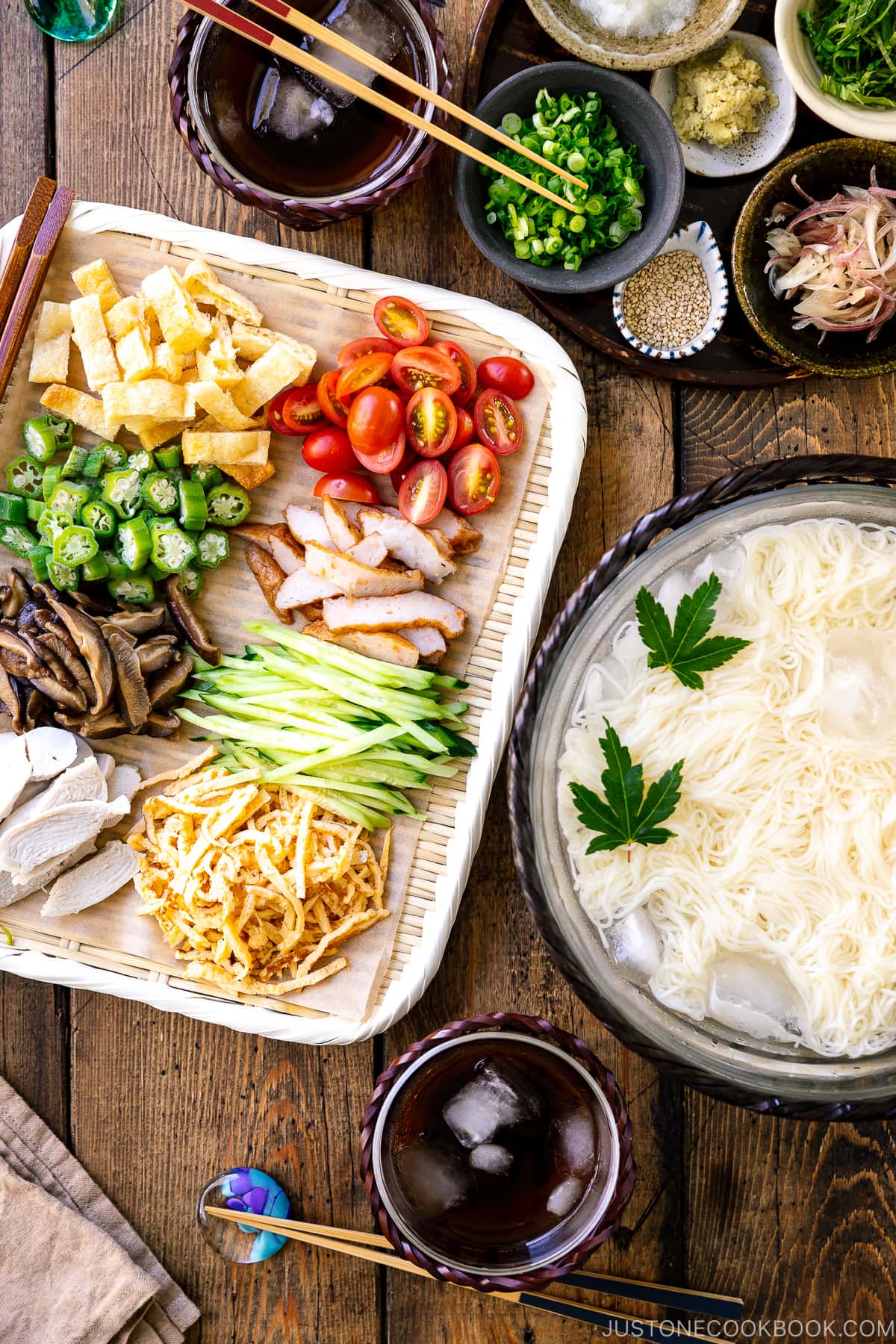
What do you usually end up eating when the weather gets impossibly warm and you start losing your appetite? Growing up in Asia, summers were often brutally hot. To beat the heat, my favorite go-to dishes on these sweltering days are Japanese Cold Somen Noodles (そうめん) and Soba Noodles. As you slurp the slippery cold noodles dipped in delicious tsuyu, you’d feel your body starting to cool in the summer heat.
Table of Contents
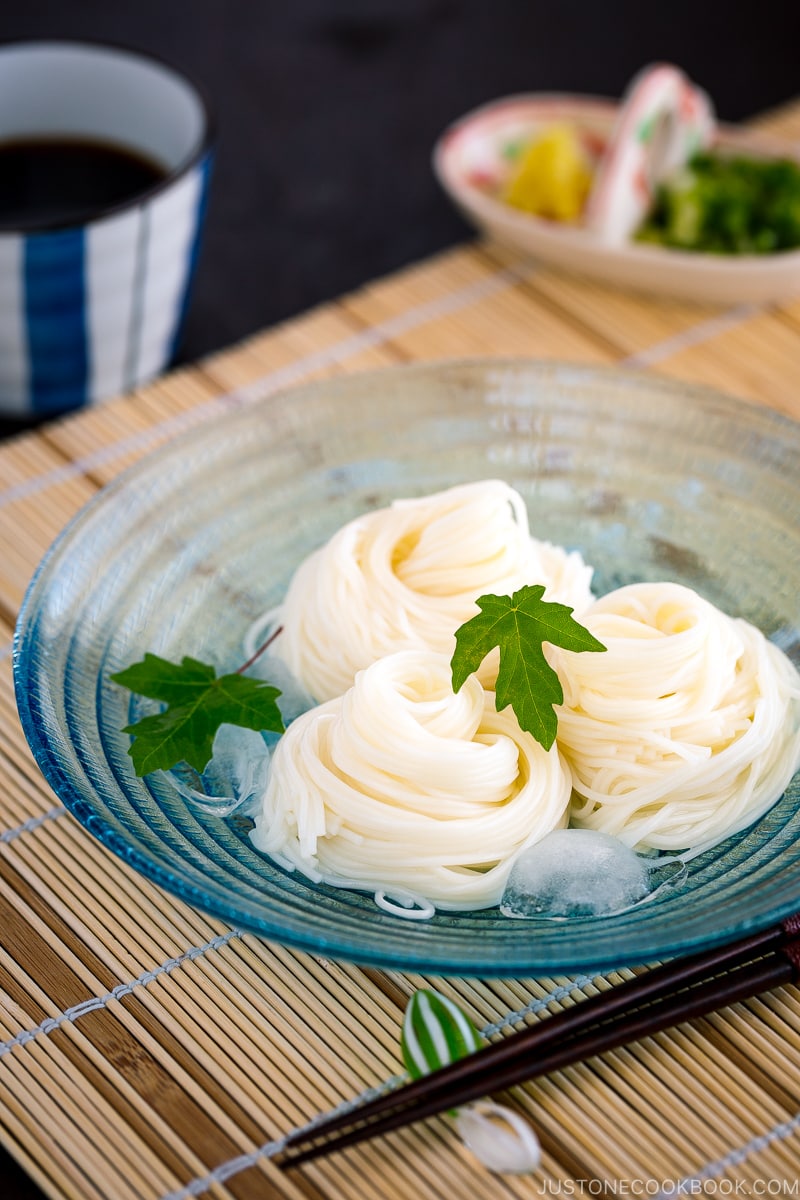

What Are Somen Noodles?
Sōmen (素麺,そうめん) are white Japanese noodles made of wheat flour and they are very thin, about 1 mm in diameter. Vegetable oil helps the dough stretch into threadlike strips. Then, the noodles are air-dried. You can read more about the somen-making process here.
Also, learn more about somen noodles on my pantry page.
Why You Should Try Somen Noodles
- Very versatile. Goes well with any broth, sauce, or toppings!
- Cooks super fast! It takes only 1 to 1½ minutes.
- Easily accessible. You can purchase a package of dried somen noodles online and in most Asian grocery stores.

Ingredients You’ll Need
- Dried somen noodles — one of few types of Japanese noodles that are sold only in dried form.
- Mentsuyu (noodle soup base) — store-bought or homemade
- Chopped scallions — for garnish
- Grated ginger — for garnish
- Optional toppings — please read below.
Where to Buy Dried Somen Noodles
Fortunately, dried somen noodle packages are available at Japanese and Asian grocery stores. My favorite brand is Ibonoito (揖保乃糸). I grew up eating this brand, and it’s still the best in flavor and texture. Therefore, I’m so happy we can now purchase this brand in the US!


The pink somen noodles are made of Ume (梅), Japanese plum. The Tenobe Somen (手延そうめん) from Shodo Island has made the region famous as one of Japan’s top three producers of somen noodles.

How to Cook Cold Somen Noodles
- Cook the somen noodles: Bring a large pot of water to a boil. You do not need to salt the water. Also, it’s important to use plenty of water so the water stays boiling when you add the dried noodles. Cook the noodles for 1 to 1½ minutes, according to the package instructions. I usually undercook slightly. Stir the noodles with chopsticks to prevent sticking. Drain the noodles in a colander immediately. Using your hands, gently knead the noodles while rinsing them under cold running water. This helps to remove the excess oil used to make super thin noodles.
- Make tsuyu, the dipping sauce: Combine the mentsuyu, water, and ice cubes.
- Serve with the dipping sauce, garnishes, and optional toppings.

How to Prepare the Dipping Sauce (Tsuyu)
Cold somen noodles are served with a dipping sauce called tsuyu (つゆ). It is the same Japanese dashi-based broth used in hot soup, but more concentrated in flavor. It’s super handy to make a big batch of easy homemade tsuyu as we use it often in the summertime!
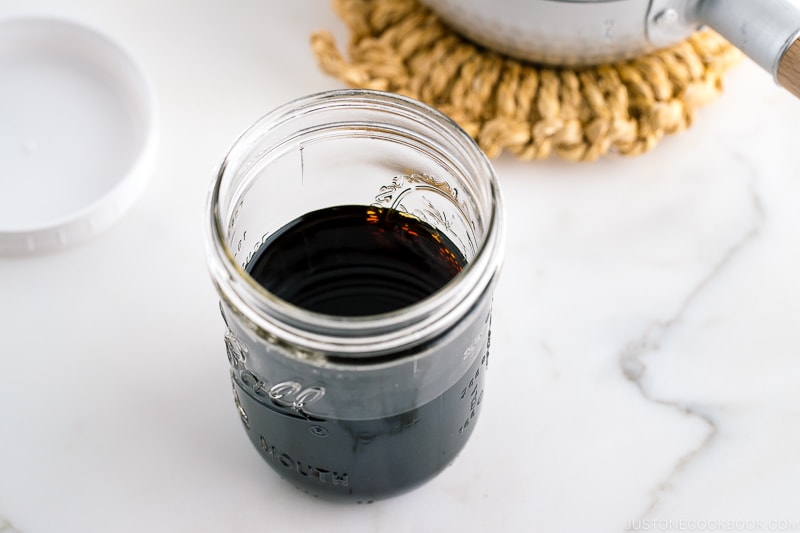

I always keep a bottle of mentsuyu in my fridge. You can purchase it from a Japanese or Asian grocery store or on Amazon. Each mentsuyu brand has different instructions on how to use concentrated or non-concentrated sauce. We call the non-concentrated noodle soup base “straight” (ストレート); you do not need to dilute it with water. Follow the instructions on the back of the bottle and adjust as needed.

Since it’s written in Japanese, I explained more on this Mentsuyu Pantry Page. If you’re unsure, try diluting the concentrate with water and taste it.
Must-Have Garnishes
I love keeping things simple by adding some chopped scallions and grated ginger to the tsuyu dipping sauce to serve with the cold somen.

You can also add julienned shiso (perilla leaves) or myoga (Japanese ginger) if you can find them at Japanese grocery stores. The dipping sauce is light yet incredibly aromatic.
Optional Somen Toppings
To make the meal more filling, you can serve the somen noodles with various toppings. Here are some fun ideas:

Proteins
- Shredded thin omelette – see How to Make Kinshi Tamago
- Chicken chashu – see my Shio Ramen recipe
- Tofu – toasted aburaage (tofu pouch), medium firm tofu, or fried tofu
- Satsuma age (fried fish cake)
- Julienned ham
Veggies and Mushrooms
- Cherry tomatoes
- Julienned cucumber
- Blanched and sliced okra
- Simmered shiitake mushrooms
Garnishes
- Sesame seeds
- Shredded nori seaweed
- Tenkasu or agedama (tempura scraps)
- Grated daikon
- Yuzu kosho
How to Serve Somen Noodles
After rinsing the noodles under cold running water, you can serve the noodles three ways.


- Option 1: Serve the noodles in iced water. (picture on the left)
- Option 2: Serve the rolled-up noodles on a plate or bamboo tray. (picture on the right)
- Option 3: Serve the drained noodles with ice cubes in individual plates/bowls. You can also roll up the noodles. (picture on the bottom)

Option #1 is a great choice on a hot day. Noodles are super cold and nice. If you are serving this dish for the family, pick option #1 or option #3. If you are serving this meal for a larger crowd (think of it as a DIY somen party!), option #2 might be a good choice, so you can pick up a portion of noodles easily.
Nothing is more comforting and satisfying than enjoying the long strands of chilled slippery somen noodles with the sweet-savory sauce on its own. It is one of the simple dishes that highlight the uniqueness of somen noodles.

Wish to learn more about Japanese cooking? Sign up for our free newsletter to receive cooking tips & recipe updates! And stay in touch with me on Facebook, Pinterest, YouTube, and Instagram.

Japanese Cold Somen Noodles
Video
Ingredients
- 4 bundles dried somen noodles
For the Dipping Sauce
- ¼ cup mentsuyu (concentrated noodle soup base) (or make Homemade Mentsuyu)
- ½–1 cup iced water (add only if using concentrated mentsuyu; for the brand I use, the mentsuyu-to-water dilution ratio is 1 to 3; therefore, I use ¾ cup water for ¼ cup mentsuyu concentrate)
For the Garnishes
- 1 green onion/scallion
- ginger (grated, with juice; grate a ½-inch, 1.3-cm knob)
- shiso leaves (perilla/ooba) (thinly sliced; optional)
- myoga ginger (thinly sliced; optional)
- daikon radish (grated; optional)
- toasted white sesame seeds (optional)
For the Simmered Shiitake Topping (optional)
- 8–10 shiitake mushrooms
- 1 tbsp soy sauce
- 1 tbsp mirin
- 1 tsp sugar
- 1 tbsp water (or dashi)
Instructions
- Gather all the ingredients (the garnishes and optional toppings are not shown).

To Make the Dipping Sauce
- I recommend making Homemade Mentsuyu for the best flavor, but you can also use store-bought mentsuyu. Most are concentrated, and every brand has slightly different instructions on how to dilute it. I explain a bit more on my mentsuyu pantry page. The brand I use recommends a dilution ratio of one part mentsuyu to three parts water, or 1 to 3.

- Combine ¼ cup mentsuyu (concentrated noodle soup base) and ½–1 cup iced water in a measuring cup and mix well. If your mentsuyu is not concentrated (labeled “straight“ on the bottle), then you don‘t need to dilute it. Tip: Include several ice cubes as part of your measured water to keep your dipping sauce chilled and refreshing.

To Prepare the Garnishes
- Cut 1 green onion/scallion into thin slices and grate the ginger (I use a ceramic grater) and put them separately in small bowls. I highly recommend shiso leaves (perilla/ooba) and myoga ginger for somen, if you can find them. Thinly slice and place them in separate small bowls. Grate a small amount of daikon radish (optional), gently squeeze some of the liquid out, then place in a small bowl. Pour some toasted white sesame seeds (optional) into a small bowl. Gather all the garnishes on a tray, if desired, and set aside.

To Prepare the Toppings (optional)
- To make the meal more filling, you can prepare toppings such as chicken chashu, simmered shiitake mushrooms (see next step), blanched okra, toasted aburaage, shredded thin omelette (see How to Make Kinshi Tamago), julienned cucumbers, thinly sliced Satsuma age, and cherry tomatoes. Find more ideas in the blog post.

- To make the simmered shiitake mushrooms, remove the stems from 8–10 shiitake mushrooms. Cut the caps into thin slices. In a saucepan, combine the mushroom slices, 1 tbsp soy sauce, 1 tbsp mirin, 1 tsp sugar, and 1 tbsp water (or dashi). Simmer, uncovered, until there is almost no liquid left. Set aside to cool.

To Cook the Somen Noodles
- Bring a large pot of water to a boil. (You do not need to add salt to the water.) Meanwhile, remove all the wrappings from 4 bundles dried somen noodles, as all the noodles should go into the boiling water at the same time. Tip: Somen noodles cook very fast, so it‘s important to work quickly.

- When the water is boiling, add the somen all at once, spreading the noodles around the pot in a circular motion to separate each strand (I use a motion similar to opening a Japanese folding fan).
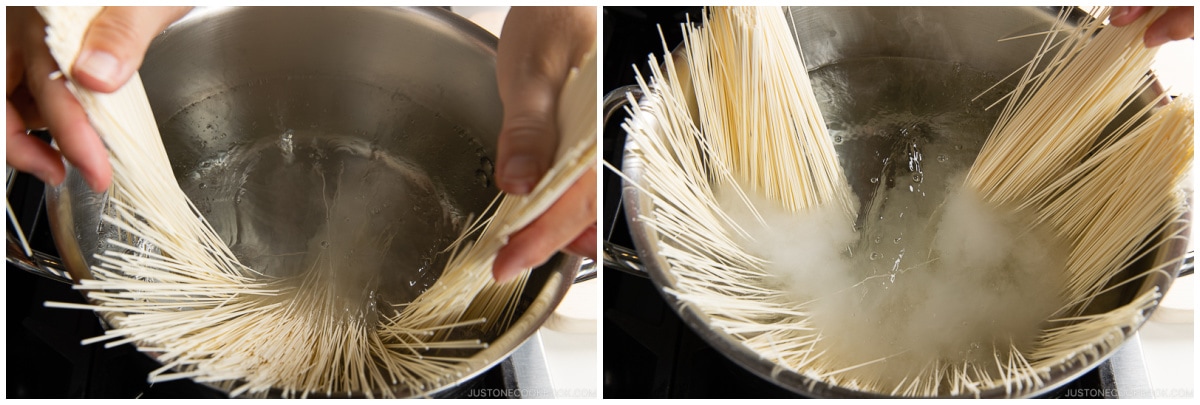
- Cook in the boiling water, stirring occasionally with chopsticks, for 1 to 1½ minutes or according to the package instructions. If it looks like the water may boil over, add a small amount of cold water to the pot. When the noodles are done, drain them in a colander. Tip: I slightly undercook my noodles to keep their springy texture.

- Next, rinse the somen under cold running water. Once the noodles are cool enough to handle, rinse them with your hands as if you are washing your clothes. Knead and massage the noodles to get rid of the excess oil. When you finish, transfer the somen to a large bowl of iced water with several ice cubes.

To Serve
- Cold Somen Noodles are often served family style in Japan, either chilled in iced water or on a tray. To serve in iced water, keep the chilled noodles in their large bowl of water with plenty of ice cubes. Decorate with green leaves such as the Japanese maple I used here. Serve the tsuyu dipping sauce in small individual bowls or cups.

- Alternatively, you can serve the somen on individual plates or a large serving platter. With chopsticks, neatly roll the chilled noodles into small bunches and arrange on your plates/platter (I used a Japanese bamboo serving basket). Place the bowl or tray of somen in the center of the table along with the garnishes and optional toppings you prepared earlier. To eat, sprinkle a few garnishes and toppings into your tsuyu, dip some somen in your sauce, and enjoy.

To Store
- You can keep the leftovers in an airtight container and store in the refrigerator for up to 2 days. If the noodles stick to each other under refrigeration, run them under cold water to loosen them up before serving. Ideally, you should boil the noodles right before serving so they won't lose their perfectly springy texture.
Nutrition
Editor’s Note: The post was originally published on August 14, 2013. It was updated with new images, content, and a revised recipe on September 5, 2022, and republished on July 2, 2024.

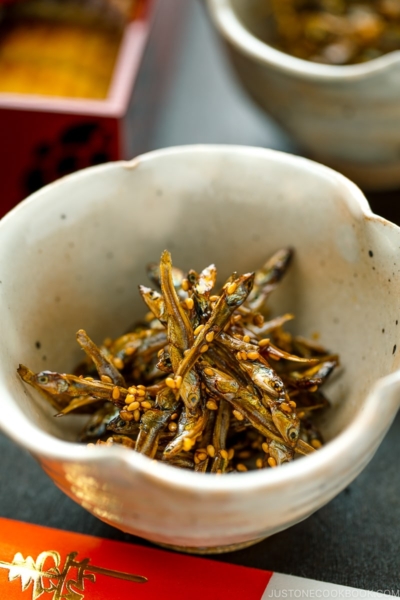







Tips on blanching okra, please. 🙂 I don’t cook with okra because it becomes very slimy but I love it and I think blanching will result in less slimy-ness. 🙂
Hello, sunflowii. Thank you for trying Nami’s recipe.
Nami explains how to blanch it in the Okura Ohitashi recipe.
https://www.justonecookbook.com/okra-ohitashi/
We hope this helped!🤗
I brought some water to a boil, then added the okra and boiled for 1.5 minutes, then fished them out and put them in cold water for a few minutes. The slime is still present after blanching.
Hi, Toshi! You can try reducing the cooking time to minimize slime and use iced water to cool off, but it won’t eliminate it entirely because of the nature of Okra. 😉
That’s right, there is slime released. But the okra itself is crunchy, fresh and not mushy or slimy while eating it. 🙂
I made this recipe as part of the March 2023 Cooking Challenge and loved it so much I had it for leftovers for lunch. It took awhile to make due to cutting all the toppings. Getting the thickness of the Kinshi Tamago was a little challenging, but all of my attempts tasted great and the different thicknesses didn’t seems to negatively affect the appearance.
Hello, Michael! Thank you for trying Nami’s recipe and participating in the cooking challenge!
We are so happy that you enjoyed Cold Somen Noodles!
Thank you for sharing your cooking experience and the photo of Somen with us. Happy Cooking!
I loved this recipe, but had to adapt it for gluten free. I used Korean rice/potato noodles and they worked really well. I also plated it a bit differently because it was midweek and for one person. It is still quite warm here in Australia so this was very refreshing!
Hi Amy! Wow! Excellent work! Thank you for sending us your photo.
We are happy that you were able to adapt Nami’s recipe to meet your needs. It also made us happy.
Thank you for your kind feedback!
Ola Nami!
Nossa quantas cores isso me faz lembrar que está faltando um monte de coisas na minha dispensa.
Lindos pratos como sempre. Essa fotos só nos dá mais vontade de cozinhar, cada vez mais.
Obrigado pela sua dedicação.
Syd.
Hello, Syd! Thank you so much for reading Nami’s post and trying her recipe!
We hope you enjoy the cold Somen Noodles!
Happy Cooking!😊
Growing up with a Japanese mother, we had somen noodles many times. Funny thing is, she never called them somen noodles, but tsumetai (cold) noodles. I didn’t know the proper name for them until I was grown up!
Hi Brenda! Thank you for reading Nami’s post and sharing your cute story! 💞
I had cold somen for the first time at a hot spring in the tiny town of Nakagawa in Northern Hokkaido. Something about that quiet, cool, refreshing meal really stuck with me such that I remember it vividly more than 10 years later. The tsuyu had scallion and katsuoboshi added to it! I’ll be sure to try some of your add-ons, but I was a bit sad not to see katsuoboshi on your list.
Hi Anthony! Thank you for reading Nami’s post and for your feedback!
We are sorry to make you sad not including Katsuobushi in the list. Optionally you can sprinkle it as you saw in Hokkaido, but Tsuyu has plenty of katsuobushi flavor (unless you did not use it to make Tsuyu), so Nami didn’t list it. There are so many kinds of toppings that are also different depending on the region.
We hope this helps!
Is this like angel hair pasta? Can I use this when making Neapolitan so it cooks fast, although it’s thinner. I tried to ask this under your Neapolitan recipe but for some reason it showed up on your omurice page. Thank you!
Hi Eri!
Somen noodle is made with wheat flour, and Angel hair pasta is from durum wheat semolina.
So the texture is similar. If you like the soft texture instead of spaghetti for your Neapolitan, it’s up to you. It will be a little mushy dish.🙂
Hi! Been hoping for an actual noodle recipe but these seem to be hard to find online. I am pretty comfortable with making ramen noodles from scratch, but wanted to make these to enjoy some cold noodles during the summer. Are these pretty much just very thin ramen noodles without kansui? Could you just make and eat them fresh?
Hi Artur! Somen is something we usually buy from the store because it involves many steps including drying the noodles. It’s much more complicated than making udon noodles. I found this video that explains the steps: https://www.youtube.com/watch?v=syh8tJezHXg
This is why we don’t make somen noodles at home and you have a hard time finding the recipe. 🙂
Thank you for sharing another great recipe! It was the 1st time I made somen and it did not disappoint! Very tasty, and a great change from cold soba which we make on a regular basis.
I will buy myoga ginger and shiso leaves for when I make it next.
Best,
Taline from Paris
Hi Taline! I hope you can find shiso and myoga ginger in Paris! It’s really nice kick to the noodles. I’m glad you can now enjoy two popular summer noodles! 🙂
I like cold noodles. I’ve prepared Tanabata some last week 🙂
Ohh the colorful one!? I saw the supermarkets here in Japan were selling colorful somen (mostly white, but include some pink and green colors). 🙂
What would you pair this with? Bought somen noodles accidentally bc I picked them up in a hurry and didn’t check the package, just the price tag which read udon. Anyways, I’d like to try this but I’m sure my family will want something else than just noodles 😅
Hi Kessia! Usually, we don’t put anything on Somen and serve with some side dishes – really anything you like, meat dish, vegetable dish… as long as you want to eat with this noodle.
My family eat Somen like Hiyashi Chuka too (https://www.justonecookbook.com/hiyashi-chuka-cold-ramen/) with same ingredients but with somen dipping sauce.
If you want to serve with a side dish, here are some choices: https://www.justonecookbook.com/categories/recipes/side/
I used to serve somen with a platter of fresh vegetables – tomatoes, cucumbers, carrots celery, etc and either some hard boiled eggs or kamaboko or some leftover meats like chicken teriyaki or polish sausage sliced into coins. When the weather was too hot to stay indoors, I would serve this on the back porch before walking over to the local swimming pool.
Thanks for sharing this recipe, Nami. Sometimes when it’s so hot, it’s hard to figure out what to eat. I usually just think of eating salads. I will be making this soon even though it’s never hot where I’m at.
Hi Candice! I know, it’s rarely hot in this area…. except for yesterday was like 90F here on Peninsula. 🙂 Thank you for your comment!
These cold noodles have been a favorite of mine since I lived in Japan. There is nothing better on a hot summer day !!!! Thank you for posting!
Hi Carlyn! I totally agree! At least we know one dish that is nutritious and appetizing on hot days. 🙂 Thank you for your comment! xo
Hi Nami,
I love somen in the summer and make a somen “salad” which is a recipe my sister passed onto me originally from the LA Times. I cook 3 – 4 bundles of noodles and placed cooked noodles in a 9 X 14 baking dish. I cover the noodles with shredded lettuce, chopped green onion, kamaboku or imitation crab flakes, cooked shredded scrambled eggs, and pieces of ham. Sprinkle with sesame seeds and teriyaki type of sauce/dressing. Scoop out spoonfuls to each person. Yum.
Hi Randy! Yes, I eat it like Hiyashi Chuka (with eggs, crabs, shredded egg crepe, etc) too! Moms always prefer to feed some protein and veggies with noodles, so I never actually had just noodles only… no matter how hot day it was. 🙂 Thank you very much for your kind comment!